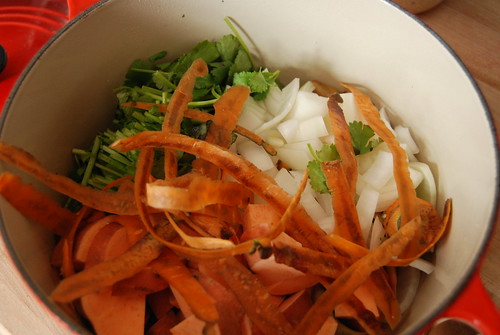January 27, 2011
Making Stock
In case you are wondering, this is not a photo of my compost bin. Unfortunately, I must admit, that I do not currently have a place to compost my food scraps. I left my worms with my friend Jen in Maine and have yet to replace them. This summer I hope to have a good composting system in place, but, until then, I don't want my food scraps to totally go to waste. Instead of tossing them I make veggie stock.
Making veggie stock is a good way to use up the scraps from preparing other meals and to make soups and other dishes even better. I never buy the sodium rich stock that you find at the store and if I don't have any stock on hand when I am making soup, then I usually just use water to make the broth.* Veggie stock is so easy to make and doesn't require hours of cooking like meat stocks do.
I'll go over the basic ideas that I use before I put the steps into a recipe: I make stock when I have enough ingredients since I prefer to use scraps rather than buying vegetables to make into stock. Of course you don't want to use spoiled vegetables or anything that you wouldn't want to eat, but it is fine to use peels from vegetables like carrots and potatoes. When I am making meals, I try to remember to save the scraps and peels. I keep them in a container in the fridge until I have enough to make a stock with. You can also make a stock while you are preparing vegetables for the soup by using the scraps, peels and trimmings as you go.
Certain vegetables are always good to include in stocks. Onions, carrots, celery, garlic, leeks (their trimmings are the perfect thing to save for stock making), and herbs. The skin and seeds from squash can be used in a stock which will be part of a squash soup. You can also add cooked beans and lentils that you have leftover from other meals. I recently added apple peels to a stock since I had a bunch of them. This made the stock a little bit sweet so I might use it for a soup or a curry where sweetness is part of the flavor. Rinds from cheese like parmesan can be used to add a great flavor to stocks.
All this discussion of peels reminds me that it is best to use organic produce when making stock. Peels of many vegetables may be sprayed with pesticides which you don't want to add to your food. Other things you don't want to add are very strong flavored veggies or herbs, unless you want that flavor in your soup. Beets will turn a stock red, which would be perfect for beet soup, but not ideal for other recipes. It took me a while to start making stock regularly because in my mind it would be complicated and easy to ruin. Once I started making it, I discovered it is simply a good way to reuse what you've got to make something from scratch.
Vegetable Stock
Much of what I have learned about stock making comes from How to Cook Everything Vegetarian by Deborah Madison, but this recipe is the process that I use regularly.
Obviously you can use stock for soups. You can also use it for liquid in other recipes such as curries, or risottos. When it comes to making the stock don't worry too much about the ingredients. Use what you have and experiment until you find what works best for you.
What you need:
A tablespoon of olive oil
An onion or two, diced (you could also use scallions or leeks if you have those instead)
Several cups of veggie scraps, peels and peicesCooked beans or lentils if you have them
Any other scraps, like cheese rinds or seeds that you want to add
Herbs, such as parsley (I use the stems which I don't use in other recipes), bay leaves, thyme or whatever is appropriate for a particular soup Water
Salt
In a large pot, heat the oil over high heat. Add the onion and let cook for a few minutes. Then add the rest of the vegetables, scraps and herbs. Cook, stirring occasionally, for 5 to 10 minutes. Ideally you want the vegetables to be brightly colored, even caramelized a bit here and there. This will add more flavor to the stock. Once the vegetables are deeply colored, add enough water to cover them well. For every quart of water you pour in, add a teaspoon of salt. Bring to a boil and then let simmer for about 30 minutes. Strain out the vegetables and store in a jar in the fridge or freezer, or use right away.
*In case you were wondering, as I was, what the difference between stock and broth is, it seems that stock is made from vegetables (and bones if you like that sort of thing) and then used as the broth in a soup. Broth can also include pieces of vegetables and meat, but it is okay to use the two terms interchangeably.
Labels:
pantry staples,
recipe
Subscribe to:
Post Comments (Atom)


No comments:
Post a Comment